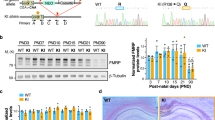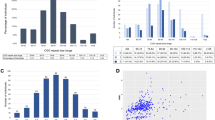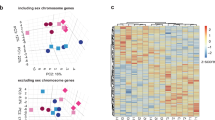Abstract
X-linked mental retardation is a common disorder that accounts for 5–10% of cases of mental retardation in males. Fragile X syndrome is the most common form resulting from a loss of expression of the FMR1 gene. On the other hand, partial duplication of the long arm of the X chromosome is uncommon. It leads to functional disomy of the corresponding genes and has been reported in several cases of mental retardation in males. In this study, we report on the clinical and genetic characterization of a new X-linked mental retardation syndrome characterized by short stature, hypogonadism and facial dysmorphism, and show that this syndrome is caused by a small Xq27.3q28 interstitial duplication encompassing the FMR1 gene. This family broadens the phenotypic spectrum of FMR1 anomalies in an unexpected manner, and we suggest that this condition may represent the fragile X syndrome «contre-type».
Similar content being viewed by others
Log in or create a free account to read this content
Gain free access to this article, as well as selected content from this journal and more on nature.com
or
References
Verkerk AJ, Pieretti M, Sutcliffe JS et al: Identification of a gene (FMR-1) containing a CGG repeat coincident with a breakpoint cluster region exhibiting length variation in fragile X syndrome. Cell 1991; 3165: 905–914.
Chiurazzi P, Schwartz CE, Gecz J, Neri G : XLMR genes: update 2007. Eur J Hum Genet 2008; 16: 422–434.
Ropers HH : X-linked mental retardation: many genes for a complex disorder. Curr Opin Genet Dev 2006; 16: 260–269.
Chen W, Jensen LR, Gecz J et al: Mutation screening of brain-expressed X-chromosomal miRNA genes in 464 patients with nonsyndromic X-linked mental retardation. Eur J Hum Genet 2007; 15: 375–378.
Raymond FL, Tarpey P : The genetics of mental retardation. Hum Mol Genet 2006; 15: R110–R116. Review.
Bauters M, Van Esch H, Marynen P, Froyen G : X chromosome array-CGH for the identification of novel X-linked mental retardation genes. Eur J Med Genet 2005; 48: 263–275.
Froyen G, Van Esch H, Bauters M et al: Detection of genomic copy number changes in patients with idiopathic mental retardation by high-resolution X-array-CGH: important role for increased gene dosage of XLMR genes. Hum Mutat 2007; 28: 1034–1042.
Madrigal I, Rodríguez-Revenga L, Armengol L et al: X-chromosome tiling path array detection of copy number variants in patients with chromosome X-linked mental retardation. BMC Genomics 2007; 8: 443.
Colleaux L, Heuertz S, Molinari F, Rio M : Fluorescence genotyping for screening cryptic telomeric rearrangements. Methods Mol Biol 2002; 204: 181–189.
Romana SP, Cherif D, Le Coniat M, Derré J, Flexor MA, Berger R : In situ hybridization to interphase nuclei in acute leukemia. Genes chromosomes Cancer 1993; 8: 98–103.
Carrel L, Willard HF : an assay for X inactivation based on differential methylation at the fragile X locus, FMR 1. Am J Med Genet 1996; 58: 1111–1119.
Novelli A, Bernardini L, Salpietro DC et al: Disomy of distal Xq in males: case report and overview. Am J Med Genet 2007; 128: 165–169.
Cheng SF, Rauen KA, Pinkel D, Albertson DG, Cotter PD : Xq chromosome duplication in males: clinical, cytogenetic and array CGH characterization of a new case and review. Am J Med Genet A 2005; 135: 308–313.
Heard E : Recent advances in X-chromosome inactivation. Curr Opin Cell Biol 2004; 16: 247–255.
Van Esch H, Bauters M, Ignatius J et al: Duplication of the MECP2 region is a frequent cause of severe mental retardation and progressive neurological symptoms in males. Am J Hum Genet 2005; 77: 442–453.
Turner G, Lower KM, White SM et al: The clinical picture of the Börjeson-Forssman-Lehmann syndrome in males and heterozygous females with PHF6 mutations. Clin Genet 2004; 65: 226–232.
Tarpey PS, Raymond FL, O’Meara S et al: Mutations in CUL4B, which encodes a ubiquitin E3 ligase subunit, cause an X-linked mental retardation syndrome associated with aggressive outbursts, seizures, relative macrocephaly, central obesity, hypogonadism, pes cavus, and tremor. Am J Hum Genet 2007; 80: 345–352.
Wilson M, Mulley J, Gedeon A, Robinson H, Turner G : New X-linked syndrome of mental retardation, gynecomastia, and obesity is linked to DXS255. Am J Med Genet 1992; 44: 854–855.
Steinbach P, Horstmann W, Scholz W : Tandem duplication dup(X)(q13q22) in a male proband inherited from the mother showing mosaicism of X-inactivation. Hum Genet 1980; 54: 309–313.
Cremers FP, Pfeiffer RA, van de Pol TJ et al: An interstitial duplication of the X chromosome in a male allows physical fine mapping of probes from the Xq13-q22 region. Hum Genet 1987; 77: 23–27.
Vejerslev LO, Rix M, Jespersen B : Inherited tandem duplication dup(X) (q131-q212) in a male proband. Clin Genet 1985; 27: 276–281.
Schwartz S, Schwartz MF, Panny SR, Peterson CJ, Waters E, Cohen MM : Inherited X-chromosome inverted tandem duplication in a male traced to a grandparental mitotic error. Am J Hum Genet 1986; 38: 741–750.
Thode A, Partington MW, Yip MY, Chapman C, Richardson VF, Turner G : A new syndrome with mental retardation, short stature and an Xq duplication. Am J Med Genet 1988; 30: 239–250.
Yokoyama Y, Narahara K, Tsuji K et al: Growth hormone deficiency and empty sella syndrome in a boy with dup(X) (q13.3–q21.2). Am J Med Genet 1992; 42: 660–664.
Apacik C, Cohen M, Jakobeit M et al: Two brothers with multiple congenital anomalies and mental retardation due to disomy (X)(q12-->q13.3) inherited from the mother. Clin Genet 1996; 50: 63–73.
Shapira M, Dar H, Bar-El H, Bar-Nitzan N, Even L, Borochowitz Z : Inherited inverted duplication of X chromosome in a male: report of a patient and review of the literature. Am J Med Genet 1997; 72: 409–414.
Monaghan KG, Van Dyke DL, Feldman GL : Prader–Willi-like syndrome in a patient with an Xq23q25 duplication. Am J Med Genet 1998; 80: 227–231.
Hol F, Schepens MT, van Beersum SE et al: Identification and characterisation of an Xq26-q27duplication in a family with spina bifida and panhypopituitarism suggests the involvement of two distinct genes. Genomics 2000; 6: 174–181.
Solomon NM, Nouri S, Warne G, Lagerstrom-Fermer M, Forrest SM, Thomas PQ : Increased gene dosage at Xq26-q27 is associated with X-Linked hypopituitarism. Genomics 2002; 79: 553–559.
Solomon NM, Ross SA, Morgan T et al: Array comparative genomic hybridisation analysis of boys with X linked hypopituitarism identifies a 3.9 Mb duplicated critical region at Xq27 containing SOX3. J Med Genet 2004; 41: 669–678.
Jehee FS, Rosenberg C, Krepischi-Santos AC et al: An Xq22.3 duplication detected by comparative genomic hybridization microarray (Array-CGH) defines a new locus (FGS5) for FG syndrome. Am J Med Genet A 2005; 139: 221–226.
Bedeschi MF, Novelli A, Bernardini L et al: Association of syndromic mental retardation with an Xq12q13.1 duplication encompassing the oligophrenin 1 gene. Am J Med Genet A 2008; 146: 1718–1724.
Gabbett MT, Peters GB, Carmichael JM, Darmanian AP, Collins FA : Prader-Willi syndrome phenocopy due to duplication of Xq21.1-q21.31 with array CGH of the critical region. Clin Genet 2008; 73: 353–359.
Tzschach A, Chen W, Erdogan F et al: Characterization of interstitial Xp duplications in two families by tiling path array CGH. Am J Med Genet A 2008; 146: 197–203.
Gecz J, Baker E, Donnelly A et al: Fibroblast growth factor homologous factor 2 (FHF2): gene structure, expression and mapping to the Börjeson-Forssman-Lehmann syndrome region in Xq26 delineated by a duplication breakpoint in a BFLS-like patient. Hum Genet 1999; 104: 56–63.
Lachlan KL, Collinson MN, Sandford RO, van Zyl B, Jacobs PA, Thomas NS : Functional disomy resulting from duplications of distal Xq in four unrelated patients. Hum Genet 2004; 115: 399–408.
Mattei JF, Mattei MG, Aumeras C, Auger M, Giraud F : X-linked mental retardation with the fragile X. A study of 15 families. Hum Genet 1981; 59: 281–289.
Peier AM, McIlwain KL, Kenneson A, Warren ST, Paylor R, Nelson DL : (Over) correction of FMR1 deficiency with YAC transgenics: behavioral and physical features. Hum Mol Genet 2000; 9: 1145–1159.
Coulam C, Adamson SC, Annegers JF : Incidence of premature ovarian failure. Obstet Gynecol 1986; 67: 604–606.
Aittomäki K, Lucena JL, Pakarinen P et al: Mutation in the follicle-stimulating hormone receptor gene causes hereditary hypergonadotropic ovarian failure. Cell 1995; 82: 959–968.
Di Pasquale E, Beck-Peccoz P, Persani L : Hypergonadotropic ovarian failure associated with an inherited mutation of human bone morphogenetic protein-15 (BMP15) gene. Am J Hum Genet 2004; 75: 106–111.
Toniolo D : X-linked premature ovarian failure: a complex disease. Curr Opin Genet Dev 2006; 16: 293–300.
McConkie-Rosell A, Lachiewicz AM, Spiridigliozzi GA et al: Evidence that methylation of the FMR-I locus is responsible for variable phenotypic expression of the fragile X syndrome. Am J Hum Genet 1993; 53: 800–809.
Acknowledgements
We express our deepest gratitude to the family for its participation in this study. This study was supported in part by the Centre National de la Recherche Scientifique (CNRS), the Agence Nationale de la Recherche (ANR), the Fondation LEJEUNE and by the Region Ile de France.
Author information
Authors and Affiliations
Corresponding author
Rights and permissions
About this article
Cite this article
Rio, M., Malan, V., Boissel, S. et al. Familial interstitial Xq27.3q28 duplication encompassing the FMR1 gene but not the MECP2 gene causes a new syndromic mental retardation condition. Eur J Hum Genet 18, 285–290 (2010). https://doi.org/10.1038/ejhg.2009.159
Received:
Revised:
Accepted:
Published:
Issue date:
DOI: https://doi.org/10.1038/ejhg.2009.159
Keywords
This article is cited by
-
Prenatal detection and molecular cytogenetic characterization of Xp deletion and Xq duplication: a case report and literature review
BMC Medical Genomics (2024)
-
Mapping the landscape of tandem repeat variability by targeted long read single molecule sequencing in familial X-linked intellectual disability
BMC Medical Genomics (2018)
-
Genomic analysis identifies candidate pathogenic variants in 9 of 18 patients with unexplained West syndrome
Human Genetics (2015)
-
De novo microduplication of the FMR1 gene in a patient with developmental delay, epilepsy and hyperactivity
European Journal of Human Genetics (2012)
-
Small genomic rearrangements involving FMR1 support the importance of its gene dosage for normal neurocognitive function
neurogenetics (2012)



